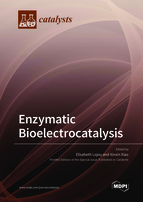Enzymatic Bioelectrocatalysis
A special issue of Catalysts (ISSN 2073-4344). This special issue belongs to the section "Biocatalysis".
Deadline for manuscript submissions: closed (31 March 2021) | Viewed by 31131
Special Issue Editors
Interests: bioelectrochemistry; redox protein; redox enzyme; hydrogenase; multi copper oxidase; electrode nanostructuration; biofuel cells
Special Issue Information
Dear colleagues,
Featuring a mild process and high selectivity, enzyme bioelectrocatalysis employing oxidoreductases immobilized on conductive surfaces is increasingly playing a vital role in a wide scope of applications. Enzyme bioelectrocatalysis is the core for devices such as biosensors and biofuel cells, which are drawing considerable attention towards sustainable sensing and energy production. A wide range of sophisticated reactions, such as chiral compound synthesis and CO2 and N2 fixation, can be accomplished with enzyme bioelectrocatalysis. Last but not least, redox enzymes are sources of inspiration for new non-noble metal electrocatalysts.
Fundamental investigations are required to alleviate the main limitations of enzyme bioelectrocatalysis, i.e., low catalytic efficiency and weak stability. In addition to the investigation of mechanisms of enzyme electrocatalysis, the molecular basis knowledge of the efficient electronic communication between enzymes and a conductive electrode is a mandatory step. Electrochemistry coupling with other in situ spectroscopic methods, as well as theoretical modeling, is expected to bring forth a fundamental understanding of enzyme conformation and dynamics on the electrode. Nanostructured electrodes and materials are significantly pushing enzyme bioelectrocatalysis forward but need further investigation to determine the molecular basis for bioelectrocatalysis optimization and stabilization. New enzyme identification in biodiversity and enzyme engineering will certainly enhance the toolbox of bioelectrochemists for high performance. Enzyme cascade broadens the scope of biocatalysis, which has also seen tremendous progress recently.
The Special Issue will focus on fundamentals, developments, and applications of enzyme bioelectrocatalysis. Reviews and original research papers are accepted. Potential topics include but are not limited to:
- Bioengineered enzymes for bioelectrocatalysis;
- Enzyme bioelectrocatalysis enabled high-value products, such as achiral ketone reduction for chiral alcohols and CO2 and N2 fixation;
- Enzyme immobilization for improved bioelectrocatalysis;
- Enzymatic biofuel cells;
- Enzymatic biosensors;
- Fundamentals of enzyme bioelectrochemistry;
- Strategies for enzyme stabilization;
- In situ and in operando techniques for enzyme bioelectrode characterization;
- Cell design for bioelectrocatalytic reaction, such as fluidic cells;
- Biodevices based on enzyme bioelectrocatalysis;
- Enzyme cascade for bioelectrocatalysis;
- Reaction media such as ionic liquid for enzyme bioelectrocatalysis;
- Nanomaterials in enzyme bioelectrocatalysis;
- Theoretical modeling of bioelectrocatalysis.
Dr. Elisabeth Lojou
Dr. Xinxin Xiao
Guest Editors
Manuscript Submission Information
Manuscripts should be submitted online at www.mdpi.com by registering and logging in to this website. Once you are registered, click here to go to the submission form. Manuscripts can be submitted until the deadline. All submissions that pass pre-check are peer-reviewed. Accepted papers will be published continuously in the journal (as soon as accepted) and will be listed together on the special issue website. Research articles, review articles as well as short communications are invited. For planned papers, a title and short abstract (about 100 words) can be sent to the Editorial Office for announcement on this website.
Submitted manuscripts should not have been published previously, nor be under consideration for publication elsewhere (except conference proceedings papers). All manuscripts are thoroughly refereed through a single-blind peer-review process. A guide for authors and other relevant information for submission of manuscripts is available on the Instructions for Authors page. Catalysts is an international peer-reviewed open access monthly journal published by MDPI.
Please visit the Instructions for Authors page before submitting a manuscript. The Article Processing Charge (APC) for publication in this open access journal is 2700 CHF (Swiss Francs). Submitted papers should be well formatted and use good English. Authors may use MDPI's English editing service prior to publication or during author revisions.
Keywords
- Bioelectrochemistry
- Bioengineering
- Biofuel cell
- Biosensor
- CO2 fixation
- Direct electron transfer
- Electron transfer
- Enzyme bioelectrocatalysis
- Enzyme cascade
- Enzyme immobilization
- Enzyme stability
- Fluidic bioelectrocatalysis
- In situ spectroscopies coupled to electrochemistry
- Mediated electron transfer
- NADH regeneration
- Nanomaterials
- N2 fixation
- Protein film voltammetry
- Theoretical modeling







